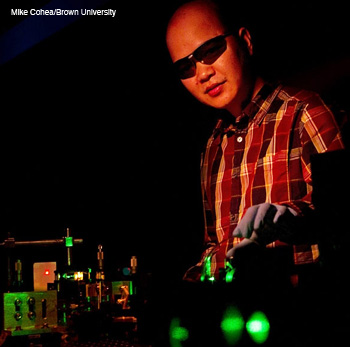Scatterings
Making an RGB Laser from Quantum Dots
Researchers at Brown University (U.S.A.) create a single-material laser that provides red, green or blue laser light.
 Cuong Dang manipulates a green beam that pumps the quantum dot vertical-cavity surface-emitting laser producing red laser light. The same quantum-dot material can also produce green and blue light.
Cuong Dang manipulates a green beam that pumps the quantum dot vertical-cavity surface-emitting laser producing red laser light. The same quantum-dot material can also produce green and blue light.
Researchers at Brown University (U.S.A.) create a single-material laser that provides red, green or blue laser light. Arto Nurmikko’s group recently reported creating a colloidal-quantum-dot vertical-cavity surface-emitting laser (CQD-VCSEL) that emits in three colors using a single material with a low threshold energy (Nature Nanotech. 7, 335). The CQD-VCSEL has potential applications in display technologies.
The electronic properties of a material determine its emission color. Therefore, different materials are typically used to create lasers of various colors. QDs don’t abide by these rules. They are so small that electron confinement changes their electronic properties—which makes the size of the particle the determining factor for emission color. QD Vision provided this study with CQDs of varying core sizes that produced red light (4.2 nm), green light (3.2 nm) and blue light (2.5 nm).
QDs are a promising material for making inexpensive lasers because they fluoresce brightly. However, QD laser manufacturers face two major problems: 1) making sure the dots are packed tightly; and 2) getting the dots to extract energy as light rather than heat. Lead author Cuong Dang and his colleagues overcame both of these problems to create a diode-laser–pumped VCSEL with a low-threshold optical pump energy density of 90 µJ/cm2—which is more than an order of magnitude lower than previously reported values.
The QDs in this study had an inner core made of a cadmium and selenium alloy and were coated in zinc, cadmium, a sulfur alloy and a proprietary aromatic ligand. The shell construction allows the QDs to be densely packed in the spin-cast films. The cladding and nanocrystal structure are critical advances in manufacturing CQD lasers, says Dang.
In the past, QD researchers got around non-light energy losses by pumping with more light. Instead, these films show optical gain across the visible spectrum with less than one exciton per CQD. This lets lasing start at low pump powers. While the overall efficiency of this laser is low, there are clear ways to optimize it in the future.
Nurmikko says, “In principle, we now have some benefits: using the same chemistry for all colors; producing lasers in a very inexpensive way, relatively speaking; and the ability to apply them to all kinds of surfaces regardless of shape. That makes possible all kinds of device configurations for the future.”
Log in or become a member to view the full text of this article.
This article may be available for purchase via the search at Optica Publishing Group.
Optica Members get the full text of Optics & Photonics News, plus a variety of other member benefits.
